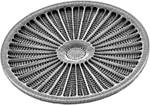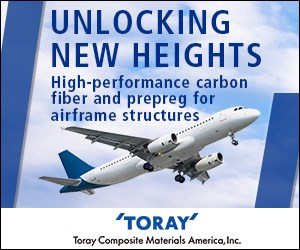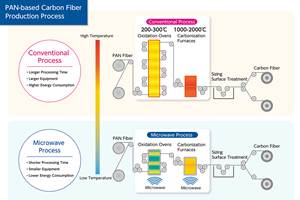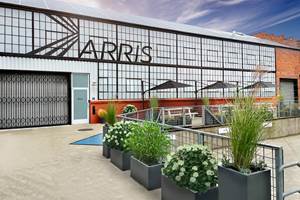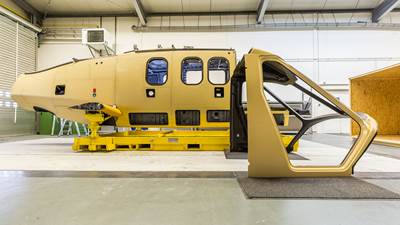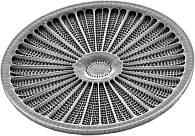Inspired by the skin of sharks (top left, clockwise), micrometer-sized riblets are being used to reduce drag for a wide range of surfaces, including the AeroSHARK technology applied by Lufthansa Technik to aircraft fuselages. Source, AeroSHARK | Lufthansa Technik. Source (All Other Images) | Bionic Surface Technologies
A biomimetic technology inspired by the skin structure of sharks, riblets are myriad micrometer-sized “ribs” that when aligned with the direction of flow reduce fluid-dynamic drag by up to 8%, cutting fuel consumption and emissions for aircraft, trains, cars and boats, for example, with corresponding benefits in noise reduction. Up to 8% less fluid friction in pipes improves efficiency in fluid transfer, combustion and other industrial processes. Applied on wind turbine blades and propellers, riblets can increase power output by up to 7% and achieve a significant reduction in power consumption for pumps and compressors.
Riblets can be applied as films, by hand or using automation, and can be laser engraved into surfaces and molding tools, the latter enabling riblet-functionalized composite parts.
The study of riblets has increased steadily since the 1980s. Riblets can be straight or curved and applied to 2D or complex 3D surfaces for a wide range of materials including metals, polymers and composites. They can be achieved via films and coatings, directly engraved into a surface using a laser or molded into a surface by machining negative riblets into a molding tool. (Note, riblet-like features are also being added to parts using additive manufacturing as discussed by CW’s sister magazine, Additive Manufacturing Media.)
Bionic Surface Technologies (BST, Graz, Austria) was founded in 2008 by two engineering students, Peter Adrian Leitl (CEO/CTO) and Andreas Flanschger (CEO), who began studying and developing riblet technology for industry. The company has since developed advanced computational fluid dynamics (CFD) and physical testing capabilities to design and tailor riblet surfaces per application and now has completed more than 800 projects worldwide.
As composites are asked to provide multiple functions beyond lightweighting to improve sustainability, using riblet films, coatings or molded surface textures could offer unique opportunities to provide new solutions.
Applications evolution
The first important project for BST was in 2009, when it applied riblets as a film on an acrobatic aircraft that competed annually in the Red Bull Air Race World Championship. “The pilot was very happy with the performance, and we only removed it after 4 years because the airplane got new branding,” says Flanschger. “It could have lasted for at least 5-6 years.” Riblets were used in other such aircraft and BST continued to collect and analyze data on their design and performance.
Computational fluid dynamic (CFD) analysis shows high fluid flow resistance (red, left) eliminated by using riblets (right).
Early applications included carbon fiber-reinforced polymers (CFRP) in motorsports. Riblets are now being explored for electric vehicles.
The second key application was for motorsports. Audi Sport (Neckarsulm, Germany) began with BST wind tunnel testing with riblets film on GT race cars in 2010. “The results were impressive, and for 3 years we were very successful in motorsports,” says Flanschger. “This was another important step to establish the technology. But we couldn’t talk about the programs publicly. And then in 2013, the use of riblets was banned in many motorsports because they gave such an advantage yet weren’t available to all teams because there were no other suppliers.”
However, in 2014, another key application began via collaboration with aircraft services provider Lufthansa Technik (Hamburg, Germany), which eventually led to its AeroSHARK technology.
AeroSHARK
Although BST is prohibited from discussing AeroSHARK technology in depth, Lufthansa Technik has covered it widely in videos and websites. It is described as a durable film manufactured by BASF Coatings (Münster, Germany) with millions of 50-micrometer-high prism-shaped riblets. Already applied to Boeing 747 and 777 aircraft by six airlines, AeroSHARK has logged 138,000-plus flight hours, saved 7,500-plus metric tons of jet fuel and avoided 26,000-plus metric tons of CO2 emissions.
“You apply it like you would a decal film or foil,” says Flanschger. Airlines already apply their liveries as a decal, and even though AeroSHARK is significantly more complex, Lufthansa Technik reports that once in service, the cost savings from fuel savings provides a return on investment in just 2 years.
“In 2022, BST applied tailored riblet film to all surfaces of a business jet — around 80 square meters,” says Flanschger. “Even though this included very complicated shapes, the film was easy to handle and it took two people only 2.5 working days to complete.” He notes BST measured a 9% reduction in fuel consumption — compared to only 1% for the fuselage of large commercial aircraft — but this included riblets also on the small jet’s wings, nacelles and empennage. “We didn’t use them on the rudder or control surfaces because it is not yet fully understood how to optimize riblets for those structures,” he explains. Still, it’s obvious that the fuselage is only the beginning of what is possible.
“The issue if you want to put riblets on the wings and empennage is obtaining certification,” says Flanschger, “because you have additional loads and it’s much more complicated than putting it only on the fuselage.” The testing for certification on wings is also lengthy and expensive. The drag reduction possible also depends on the aircraft. “The reduction in fuel consumption depends on the flight altitude, which determines the air density, and also the flight loads,” says Flanschger. “So, with mid-size commercial aircraft you may reach 4-5% savings.”
An article in Lufthansa’s Innovation Runway series reports Lufthansa Technik is already planning to certify AeroSHARK for other aircraft types and also other surfaces beyond the fuselage. Meanwhile, in addition to its Novaflex AeroSHARK film, BASF has developed a second riblet film, Novaflex BladeUp, for wind turbine blades.
Wind turbine, helicopter rotor blades
In 2022, BASF Coatings announced it had teamed up with wind turbine maintenance company Omega-Tools GmbH (Ritterhude, Germany) and turbine operator Energiekontor AG (Bremen) to equip the latter’s turbine blades with Novaflex BladeUp film. The company reported that riblets reduce the formation of air turbulence on the blade surface, increasing power output by up to 3% on an initial 1.3-megawatt SWT 1,300 turbine (produced by AN Bonus) in Ilsede, Lower Saxony, Germany. Omega-Tools added that installation of the films can be done without long downtimes for the turbines.
BASF is working to extend Novaflex BladeUp to other wind turbine and blade manufacturers and believes that the riblet film could be integrated into the blade manufacturing process, enabling new wind turbines to generate a higher electricity yield.
Flanschger notes BST has trialed riblets on other blade structures, including rotor blades on helicopters. “There, we saw a massive improvement — more than 5% greater lift for the helicopter. This is especially interesting for forward flight.” Unlike fixed-wing aircraft, a change in forward air speed causes a “dyssmmetry of lift,” where one half the disc of the rotating rotor blades advances into the air flow and the other half moves with it. This increases the airspeed on the advancing side, generating significantly more lift, and decreases it on the retreating side, opening the risk of “retreating blade stall” which can cause the helicopter to roll and pitch uncontrollably. Currently, this issue is addressed by a variety of design and control measures, including letting the blades “flap.” Flanschger estimates riblets could provide an additional tool to improve blade design, “but this is ongoing research for us at the moment.”
Laser engraved and molded riblets
Riblets have also been used on aircraft engine fan blades as well as low pressure turbine blades and shrouds. Some of this work has been completed by Nikon Corp.’s Advanced Manufacturing Business Unit (Belmont, Calif., U.S.). Possible benefits include reducing the amount of bypass air flow required or using current air flow to increase power output and efficiency, reducing fuel consumption and emissions.
Nikon is a key partner for BST, and the companies have been working on this and other projects for more than 5 years. However, for these structures, riblets are not achieved by applying a film but instead laser processing to create customized riblet patterns on metals, polymers and already applied films and paints.
Similarly, riblets can be applied to the blades of impellers used in pumps, compressors and turbomachinery. “We have done many projects on pumps, including an ongoing project at the moment, and also with power plants,” says Flanschger. “And here too, riblets are directly lasered into the coating or into the metal. But this is also a technique possible for the composites industry, by engraving the riblets into the mold and then producing a part that is optimized and ready to use.”
This approach has been used for impellers but also has potential for pipes. BST is working with a company in Norway that produces glass fiber-reinforced composite water pipes. “By engraving riblets in the molding tools,” notes Flanschger, “they could produce, for example, an 8-meter-long water pipe with riblets inside.”
Propellers, ships, hydrofoils
BST is also pursuing research on carbon fiber propeller blades for aircraft, where Flanschger believes the benefits would be significant. “We have applied for EU-funded projects and are still looking for partners,” he says. “The application would be to laser engrave negative riblets into the aluminum mold for curing the prepreg or infused laminate and the resulting parts will have the tailored riblets.”
Ship propellers are similarly interesting. In tests on commercial ship propellers, BST has achieved a 3-5% increase in efficiency. “If you calculate this for a large container ship — for example, one of the latest from China that are 400 meters long — this would equate to 200,000 less liters of diesel consumed per year and the corresponding emissions,” says Flanschger.
However, many companies are resistant, believing their expertise in producing very shiny, super smooth propellers is what demonstrates their quality and expertise. “In reality, we are in a new era that demands new solutions,” he observes. “For example, maritime applications also includes riblets for defense, because if you apply them on submarines, torpedoes and underwater drones you have less noise from the hull and also from the propeller because turbulent flow is reduced.”
It seems riblets would also be perfect for hydrofoils. “Yes, they have a massive effect on foils,” says Flanschger. “The foil is not really large, yet riblets produce an extremely high efficiency increase compared to the area.” And though they are forbidden for use in sports applications, riblets could boost efficiency for foiling electric boats — including water taxis and ferries — where every bit of performance helps to offset the weight of batteries, for example, further extending vessel payload and/or range.
A key example for these propeller, hull and hydrofoil applications is the regulation starting Jan. 1, 2026, that all tourist ships and ferries under 10,000 gross tons traveling in the West Norwegian Fjords must be zero-emission vessels. This will extend to larger ships on Jan. 1, 2032. Again, a 3-5% increase in efficiency could directly apply to the bottom line for vessels adopting battery electric, hydrogen fuel cell and/or biogas to power zero-emission propulsion systems.
CFD analysis, challenges and next-generation riblets
But isn’t the CFD analysis required for such applications very complicated? “Yes, but this is our business, to perform these CFD analyses and help to optimize use of riblets on a wide range of structures,” says Flanschger, noting the CFD tools that BST has developed make the process much easier, including simulation automation and a vast database of designs and results. He also points out that riblets are not magic — they cannot make something that is bad good, “but if there is something good, then riblets can make it the best. This is always how they perform with applications involving aerodynamics and fluid dynamics.”
But Flanschger acknowledges that repair of structures using engraved or molded riblets could pose a challenge. “You need the riblets to remain very precise,” he explains. “For example, they must be in the correct direction and orientation.” He notes this is one advantage of using a film — you can simply repair the part and reapply the film as needed.” Some who have studied riblets on aeroengine nacelles have also noted that if they become dirty, their performance is diminished. “Therefore,” says Flanschger, “material experts play a major role to develop material for riblets which are dirt-repellent.”
Over the last few years, BST CTO Leitl has developed a new generation of patented riblets that promise even higher performance. Where AeroSHARK and other applications have shown up to an 8% drag reduction, with these new riblets, Leitl is targeting 12% with potential for up to 14% drag reduction. “The initial results from testing in 2024 look promising,” says Flanschger, “but much work remains and we are still looking for a commercialization partner.” He notes BST knows many potential partners and discussions are ongoing, “but it’s important to engage with new companies and possibly identify new applications that could really have an impact on the challenges we face in industry and sustainability.”
Related Content
Novel composite technology replaces welded joints in tubular structures
The Tree Composites TC-joint replaces traditional welding in jacket foundations for offshore wind turbine generator applications, advancing the world’s quest for fast, sustainable energy deployment.
Read MoreMicrowave heating for more sustainable carbon fiber
Skeptics say it won’t work — Osaka-based Microwave Chemical Co. says it already has — and continues to advance its simulation-based technology to slash energy use and emissions in manufacturing.
Read MorePlant tour: Arris Composites, Berkeley, Calif., U.S.
The creator of Additive Molding is leveraging automation and thermoplastics to provide high-volume, high-quality, sustainable composites manufacturing services.
Read MorePlant tour: Middle River Aerostructure Systems, Baltimore, Md., U.S.
The historic Martin Aircraft factory is advancing digitized automation for more sustainable production of composite aerostructures.
Read MoreRead Next
Leveraging motorsports composites for next-gen rotorcraft
FastCan consortium integrates hollow, solid and cored CFRP into single-cure, single-piece canopy for reduced weight and cost.
Read MoreBionic design: The future of lightweight structures
Biomimicry evolves into a systematic design process for optimizing efficient, lightweight structures.
Read MoreFACC equips 2,000th Airbus aircraft with Sharklets
Eight-foot-high composite components furnish the Airbus A320 Family, enhancing fuel efficiency via their biomimetic design.
Read More


